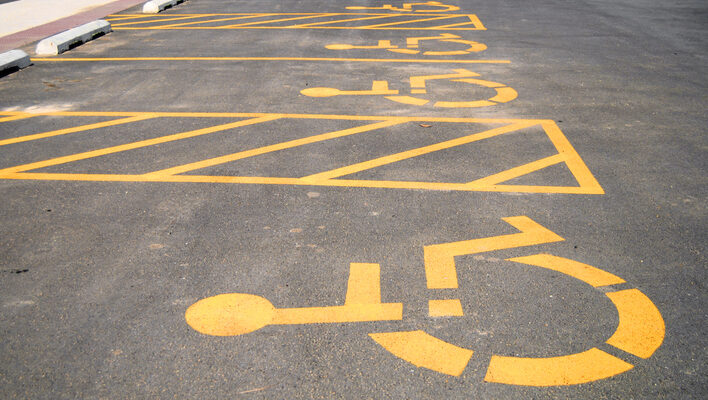Many small business owners get caught off guard by ADA lawsuits, don’t let yourself be one of them.
The Americans with Disabilities Act (ADA) is a law that guarantees access to public businesses to people with disabilities. If you don’t adhere to these guidelines, you could face civil suits from individual plaintiffs, as well as fines or legal action from the Department of Justice (DOJ). This article will detail what ADA lawsuits are and how they can cost your storage facility.
What is the ADA ?
The Americans with Disabilities Act (ADA) is a federal law that requires private employers, state and local governments, employment agencies and labor unions to provide reasonable accommodations to qualified employees or applicants with disabilities. These protections also extend to anyone who visits a business that is open to the public such as a restaurant, hotel, store and, of course, a self-storage facility.
Reasonable accommodations are adjustments or modifications provided by a business to enable people with disabilities to enjoy equal employment opportunities. Common examples include providing a ramp for a wheelchair user or providing materials in accessible formats such as large print, Braille, or audiotape.
What are some of its implications for self-storage owners?
The ADA is designed to prevent discrimination against individuals with a disability and ensure they can participate in society as easily as anyone else. ADA lawsuits are not just brought against big corporations but also small local businesses. Cases can be brought by employees, as well as customers.
The ADA is very specific as to what accommodations are required.
If a person with disabilities visits your facility and discovers that any part of your property is not meeting those requirements, they have grounds for a lawsuit. Some lawsuits are brought by serial filers, who visit businesses regularly looking for potential violations of the ADA. No matter the nature of the lawsuit, however, your business could be liable for every violation of the ADA.
ADA Liability
The requirements of the ADA are outlined in the document titled ADA Standards for Accessible Design (the Standards). These Standards include provisions regarding an establishment’s:
- Parking lot
- Walkways
- Doorways
- Restrooms
- Other areas of a building or facility that are open to and used by public members.
If a business fails to comply with these standards, it can be sued under Title III of the ADA. Title III covers any private entity that owns, leases, or operates a place of public accommodation—which includes retail stores, restaurants, and hotels—or commercial facilities such as office buildings and factories. It also applies to state and local governments when they provide programs, activities, or services that affect interstate commerce.
How much could an ADA lawsuit cost?
Suppose a business fails to comply with ADA regulations and someone files a lawsuit. In that case, it may need to pay compensatory damages—such as compensation for lost wages or medical bills—and cover that person’s attorney fees. On average, that could cost about $25,000—not including your own legal fees. The amount of money awarded in compensatory damages depends on what kind of harm occurred because of noncompliance. In addition, the business will have to spend money completing the needed repairs and upgrades to comply with the ADA.
ADA Compliance Checklist
While many businesses have taken significant steps to make their establishments ADA compliant, others have fallen behind or do not understand what these laws mean for them. To avoid a costly lawsuit, evaluate your property on a regular basis to make sure that it is up to ADA standards. If your facility isn’t compliant, start working upgrades into the maintenance schedule to protect your business from ADA liability.
Entryways
Making your facility accessible to individuals with disabilities begins with physical access from public sidewalks, public transportation, or parking. Having only one step at the door can prevent wheelchair, walker, or cane users from entering and make entry difficult for many other people with mobility problems.
Where there are one or two steps at an entry, users can gain access in a variety of ways, such as by using an alternate accessible entrance, creating a short ramp, changing the area in front or to the side of the door to eliminate a step, or installing a lift.
Ramps
Curb edges and other dangers can be extremely harmful to those with impairments. The ADA curb ramp regulations are in place to help prevent persons from falling out of wheelchairs or scooters or tripping when walking with a cane or walker. Accessibility is also a consideration, as federal regulations consider barring access in public places as discrimination.
Parking Spaces
The suitable stall sizes, markings, and slot positions must be considered and observed to fully comply with the norms and regulations for handicap-accessible parking. If you choose to apply new markings to a new parking facility or to restripe an existing one, these are the details you must be aware of to ensure compliance.
Accessible Storage Units
The ADA required self-storage facilities to comply with specific particular standards as of March 15, 2012. Here’s a breakdown of the rules:
- A minimum of 5% of the first 200 units in each self-storage facility must be wheelchair accessible.
- In addition, 2% of all units above 200 must be wheelchair accessible.
- Wheelchair-accessible units must be available in all unit types that a company offers.
- If a non-disabled renter requires a wheelchair-accessible unit, the business is not necessary to keep it.
Elevators
The elevator must be easily accessible in a public location (rather than, say, a cramped hallway). In addition:
- Doors must be fully open for at least three seconds.
- Call buttons must be at least 0.75 inches in diameter.
- Button heights must be 42 inches above the floor.
Protecting Your Business from ADA Lawsuits
It would be best if you made your facility as accessible as possible. Some visitors may experience difficulties that have nothing to do with your business. If a disabled customer has an accident and decides to file a lawsuit against you, it’s your job to prove that reasonable accommodations were made—and that someone else was at fault for any injuries or property damage caused by their actions or negligence.
To help protect yourself from ADA lawsuits, remember to always do the following:
- Make accommodations in your facility to accommodate wheelchairs and strollers. Ensure that all entrances, hallways, and restrooms are wide enough for wheelchairs.
- Install ramps and grab bars in bathrooms, if necessary.
- Install wheelchair-accessible equipment. If a customer requests assistance, train staff to provide adequate support to users of walkers and wheelchairs. Be sure to train employees on how best to assist disabled customers when they request help moving from one area of your facility to another.
- Instruct employees on what they can and cannot do. If someone has a disability-related complaint against your business, it’s essential that you can prove your employee didn’t go above and beyond their responsibilities.

